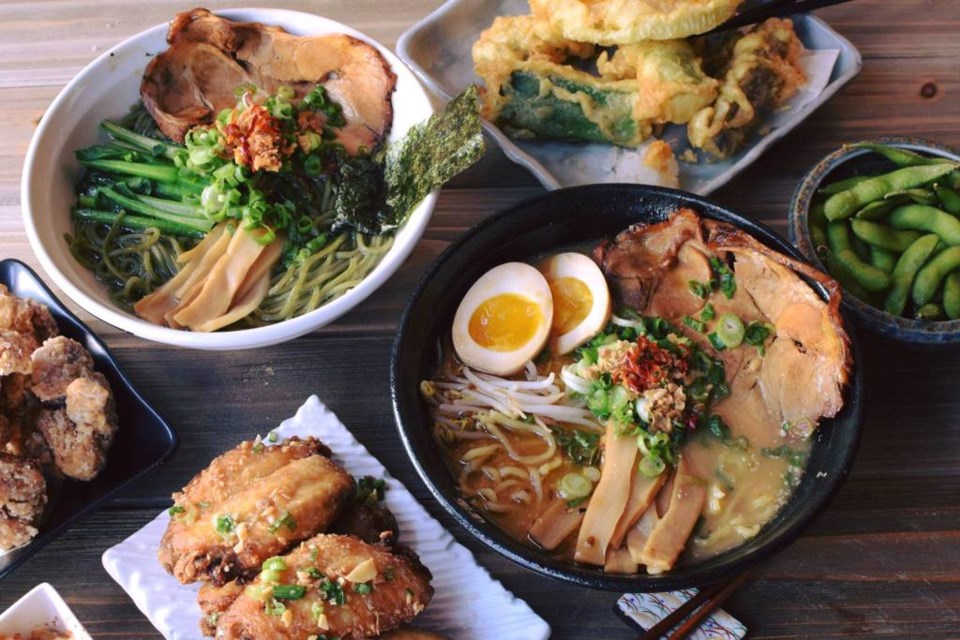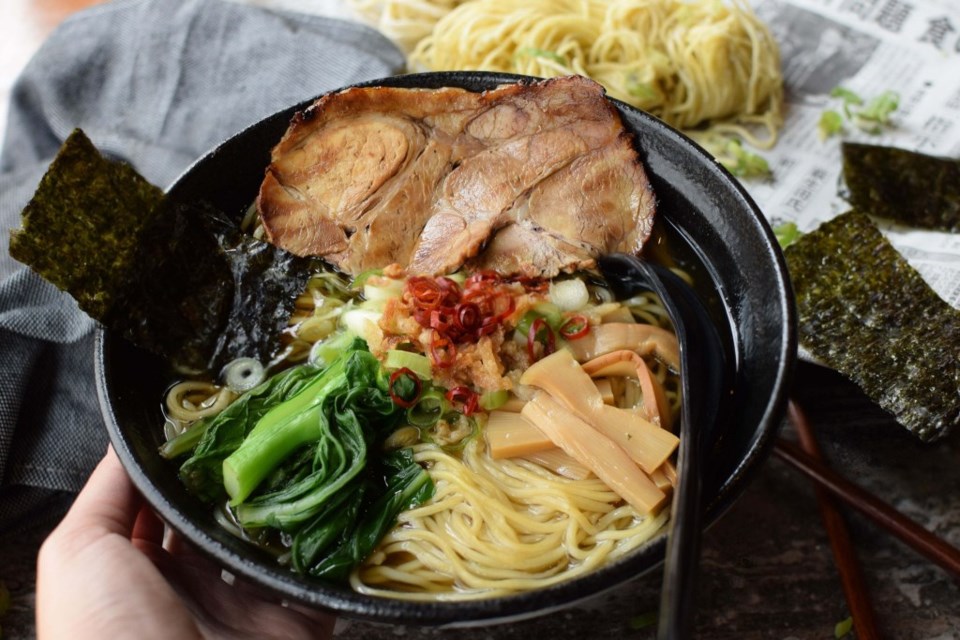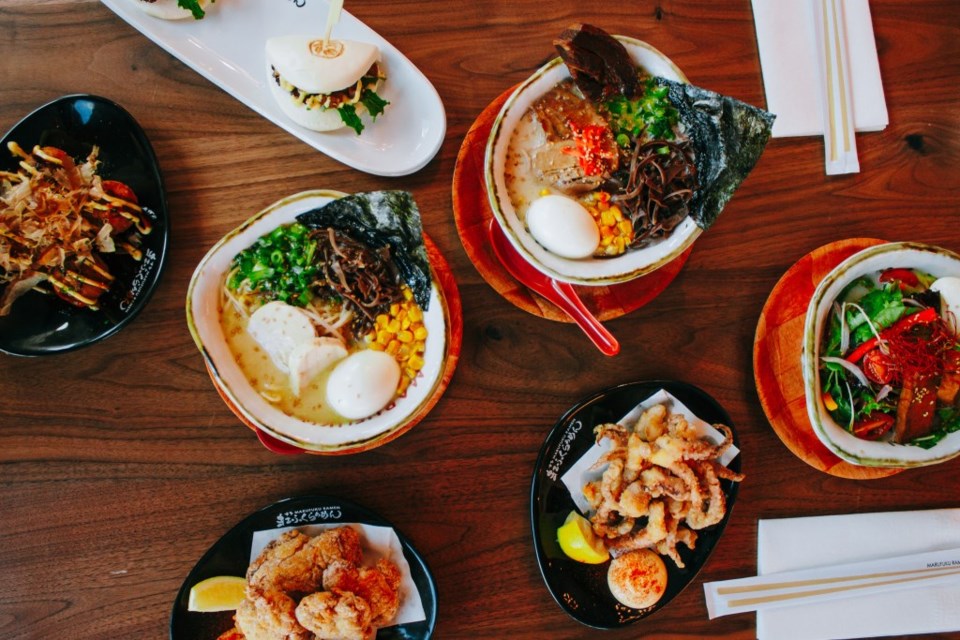Ramen is a soothing enigma, a staple among the cultured classes and their ilk. But how did this addictive dish of liquid intertwined with thick (or thin) noodles get so popular? And where did it come from?
Japanese-style ramen restaurants barely existed in the U.S. before the ramen boom struck at the dawn of the 21st century. Many attribute its popularity to the rising influence of anime, the Japanese hand-drawn and computer-generated animation with characters who often slurp and slide steaming ramen noodles down their throats. Or maybe it’s because ramen is comforting, customizable and rich in umami — that fifth savory and meaty taste after sweet, sour, salty, and bitter.
Ramen’s history traces back to A.D. 400 when the first Chinese immigrants arrived in Japan. They brought with them wheat noodles known as lamian or pulled noodles. Yet the first dishes featuring this ingredient weren’t known as ramen. That term emerged later and was likely a Japanese derivation of the Chinese word.

Legend has it that ramen was popularized when the noodle shop Rai Rai Ken opened in Tokyo in 1910. Ramen was served in a salty broth topped with roasted pork, fish cake and nori (dried seaweed) — the classic toppings found in most current recipes. Wide acceptance of the dish accelerated during the food shortages that struck Japan in the wake of the Second World War. Instant ramen was invented during this same period.
Restaurants today serve these noodles in broths flavored with soy sauce and miso and topped with chashu (sliced pork), soft-boiled egg, nori (dried seaweed), menma (bamboo shoots) and scallions. Ramen is cheap, fast food, and while some recipes (such as tonkotsu) can come off with a whiff of sweaty foot funk, this classic slurpable potion has hit Collin County hard — it’s found its noodle groove.
Kizuki Ramen & Izakaya
5760 Legacy Drive, Suite 4, Plano
945.800.9183

Kizuki Ramen & Izakaya is a phenomenon based in Bellevue, Washington, with 16 locations in Indiana, Washington, Oregon, Texas and Chicago, in addition to serval locations in Japan, Taiwan and Australia. Kizuki prides itself on authenticity. Its tawny soft-boiled eggs are marinated in a soy mixture. Its broth is rendered from roasted bones simmered for 12 to 14 hours, conferring fragrant depth. Steam billows from several pots in the open kitchen, adding ambiance to its Japan-inspired design. We greedily slurped the garlic tonkotsu shoyu ramen with pork, bean sprouts, mushroom, a whole egg, a shark fin-like slice of seaweed rising out of the broth on the bowl’s edge, and a crown of scallions and toasted garlic. Marvel at its potency. And the Kizuki restrooms are furnished with mouthwash, making the experience doubly good.
Kenzo
158 W. Farm-to-Market Road 544, Suite 118, Murphy
469.366.9165
Kenzo — a bright and colorful restaurant outfitted with knickknacks and long threads of LEDs ribboned around the glassed-in kitchen — serves sushi and a roster of ramen simmered in a rich beef base. We opted for their “famous” shoyu ramen, a bright red bowl of steaming beef and soy sauce-laced broth packed with bean sprouts, shaved carrot, scallions, a bit of pork and a split hard-boiled egg. The beef appears as a bone sheathed in meat and a bit of gristle, which makes it difficult to manipulate with chopsticks or a spoon (finger food), but the ensemble merges into a soothing melange of flavors and textures.
Marufuku Ramen
9292 Warren Parkway, Suite 370, Frisco
469.388.1215

Marufuku Ramen boasts authentic Hakata-style tonkotsu ramen, a steaming bowl of redolence that emerged in the city of Fukuoka on the Japanese island of Kyushu. Tonkotsu ramen features a rich, milky and aromatic broth crafted by boiling the bones, head, backfat and trotters (feet) of the pig for long hours. That broth is threaded with Hakata ramen noodles, which are thinner than typical ramen noodles and are served slightly firmer — perfectly al dente and augmented with chashu (Japanese braised pork belly) made from specially selected pork. We sampled the Hakata Tonkotsu DX, a masterpiece of soupery with chashu, a seasoned soft-boiled egg with a flowing yolk, green onion fragments, strands of kikurage mushroom, bean sprouts and a tiny field of corn kernel debris. At edge of the bowl rises a slip of nori (dried seaweed) as angular and sharp as a cropped pitbull ear. This fragrant crucible of comfort is served in cozy environs, with wood and stone accents, amber lighting and a crisp ramen bar where you can peek in on the ramen action. Launched in 2010 in San Francisco’s Japantown, Marufuku nurtures locations in California, Austin and New York’s East Village.
Kuma Ramen
5121 Collin McKinney Parkway, Suite 800, McKinney
214.842.8173
Kuma Ramen features Kumamoto ramen, a species that emerged in the city of Kumamoto on the island of Kyushu. But it is distinct from Hakata ramen, which hails from neighboring Fukuoka, in that it features thicker noodles and a lighter soup base composed of mild pork bone broth and enhanced with flavors from chicken bones. Kumamoto ramen also features fried garlic chips and sesame oil, which whet the appetite and complement the noodles. We supped on the tonkotsu ramen with a light milky broth, green onion, bamboo shoots, black mushroom, egg (exquisitely cooked), fish cake, seaweed and black garlic.
Tabu Shabu
1620 N. Hardin Blvd., Suite 1000, McKinney
972.548.8228
Tabu Shabu breaks new ground in the Japanese soup wars — interactive ramen. At Tabu Shabu, diners prepare their own masterpiece with a choice of broth (seaweed base, spicy miso, creamy pork bone base, or soy sake), to which they can add veggies that include Napa cabbage, carrot, baby spinach, broccoli, mushroom, tofu and Japanese pumpkin. You simmer those veggies in a metal pot before adding fresh garnishes (daikon radish, garlic, scallions, soy sauce and chili oil). When those veggies approach el dente tenderness, toss in your selected protein, everything from prime rib eye and lamb shoulder to wild shrimp and Scottish salmon. We opted for the seaweed-base broth (a bland orcanvas begging to be sassed up) and prime rib eye, a dozen thinly sliced scrolls of pink laced with thin pearly channels of fat. This McKinney outlet is part of a small chain that erupted in Eastside Costa Mesa and is primarily in California.
Ramen Hakata
327 S. Central Expressway, Allen
972.908.3434
For more than 40 years, Hakata-style ramen has garnered fame for its heady broth, a rich bowl of brawn made by subjecting pork bones and other remnants to a rolling boil over high heat for more than 12 hours. This cooking process releases bone marrow into the broth, giving it a milky yellowish appearance while striping it with gelatinous elements. You’ll be dazzled by the decadently rich flavors. You’ll marvel at the tender, firm thin noodles flown in fresh from California. We attacked the Hakata ramen with chopsticks and spoon, relishing the chashu, flaps of black mushroom, a half soft-boiled egg with a yolk as bright as a sunflower and bean sprouts, all flecked with green onion. The flavor is symphonic. It’s all cast in a crisply modern space with lots of blond wood and graphics on the wall giving briefs on the noodles, egg, braised pork and broth. Ramen rhapsody.
Yatai Ramen Izakaya
2001 Coit Road, Suite 140, Plano
972.212.4674

Yatai Ramen has a simple dining room with spartan wood accents, wooden tables encroached by padded chairs and strings of lights — traditional decor torqued with an understated urban vibe. It also comes equipped with a full sake bar showcasing more than 10 varieties. Yatai highlights six ramen variations: shoyu, tonkotsu and miso, each with a spicy version. We opted for the miso ramen, a black bowl filled with minced pork, pork chasu, egg, bamboo shoots, scallions and a tight cluttering of canned corn off to one corner. The Sapporo-style noodles are supple and tender, slipping easily out of the chicken-and-pork broth — a heady rendition.
Wahta Ramen
8745 Gary Burns Drive, Suite 165, Frisco
214.407.8118
Wahta Ramen is clean and cozy with whimsical old Japanese decor (a blob creature propped up on cases of sake, a ceramic bear, fairy lights, Japanese banner signage, a couple of old license plates) in a room with blond wood tables and a clean, almost anime, kind of vibe. We sampled the shio ramen, a chicken-and-soy-based broth medleyed with bamboo shoots, bean sprouts, scallion flecks, black mushroom, egg, chicken and swirled fish cake rendered from surimi paste. The effect is subdued — this isn’t flavor that will get your tongue tangoing, but the balance will maybe get it to two-step.




